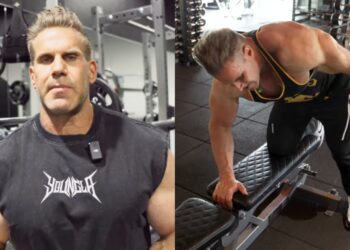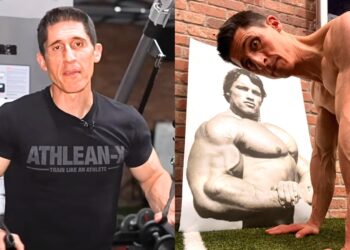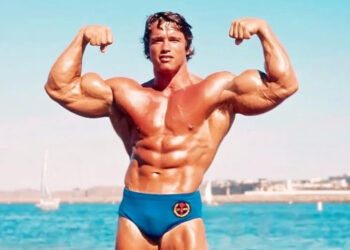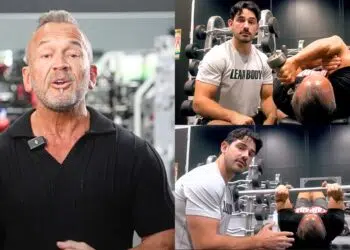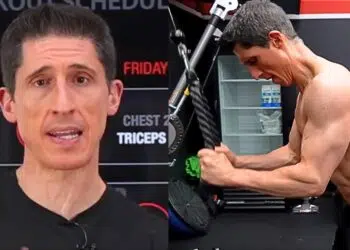Every time I do bodyweight triceps presses (also called bodyweight triceps extensions), the back of my arms are sore the next day. Especially the long head of my triceps. It’s a movement that should be in your arm day lineup, especially if you train at home, have limited equipment, or want to mix up your routine.
Most triceps exercises don’t stretch the muscles like extension-type variations. The eccentric or negative phase of a repetition lengthens a muscle under a weight load. Studies have found the eccentric to be more effective for muscle growth than even the contraction or concentric portion of a rep (more on that later) [1].
In this exercise guide, you’ll learn why we love the triceps press, how to do it, and what variations are as good or more effective…
Triceps Press – Muscles Worked
While it’s obvious triceps presses work the three headed muscles on the back of your arms, you’d be surprised to know other groups are also involved.
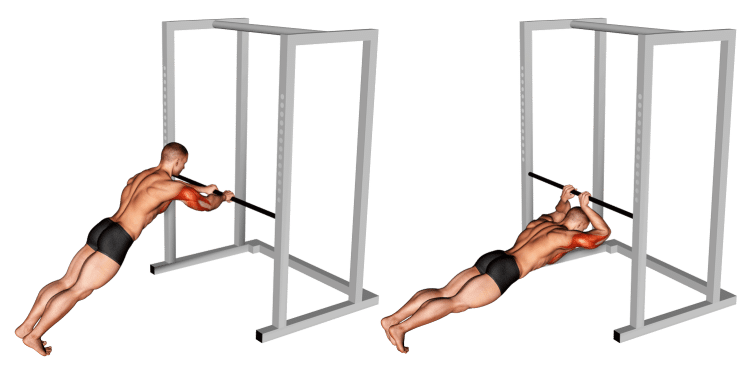
Triceps brachii
If you want amazing arms, you must dedicate training to the triceps muscles. These pushing muscles are formed by three heads – lateral (outer), medial (middle between lateral and long), and long (innermost head).
Every day, the triceps muscles contract to straighten the arm or extend the elbow. In this case, it allows us to do triceps presses. Unlike the other two heads, the long head attaches to the scapula and has a small action at the shoulder.
Level Up Your Fitness: Join our 💪 strong community in Fitness Volt Newsletter. Get daily inspiration, expert-backed workouts, nutrition tips, the latest in strength sports, and the support you need to reach your goals. Subscribe for free!
Deltoid Anterior
The deltoid muscles share something in common with the triceps, that is, three heads. The anterior head is placed directly next to the chest muscles on the front of the body. Consequently, its role is forward movement of the arm like when performing triceps presses.
Pectoralis Major Clavicular Head
The uppermost chest muscles, pectoralis major clavicular head is a section of fibers that sit below the clavicle bone. These muscles are activated when the arms are raised up and overhead. Triceps presses contract these muscles during both phases.
Pectoralis Major Sternal Head
Moving down the chest to the nipple area, you’ll find a unique section of lower pecs fibers. Opposite the clavicular head, sternal fibers are best targeted when the arms move downward. However, any pressing movement will work the sternal head as it will the upper head.
How To Do Triceps Presses
Before performing triceps presses, we highly recommend warming up your elbow joints. This will ensure you remain pain-free and prevent injuries.
You can achieve this by doing a few sets of a different triceps exercise (except for extensions), push-ups, or you can do your chest and shoulder training before triceps presses. There are several ways to warm up your elbows.
Setup
The setup for triceps presses is simple. Find a Smith machine, TRX trainer, gymnastics rings, squat rack, park rails, or similar platform with a steady bar. You can also use a kitchen counter, etc. However, you may not be able to fully stretch the triceps (but it’s better than not doing it at all).
Then, if using a Smith machine, power rack, stall bars, etc, you’ll need to determine the appropriate bar height to perform your reps. The higher the bar, the easier the exercise. This will depend on your strength ability or how much stress your elbows can take.
We recommend doing a few practice reps to find the right height for you.
Exercise Steps:
Below we’ve broken down the triceps press movement in detailed steps.
Step 1 – Hand width
It’s possible to use various hand grip when performing triceps presses. It just depends on what feels most comfortable to you and if you’re able to feel the exercise working effectively.
Typically, a shoulder width or slightly closer grip is efficient. However, you can tweak your hand width slightly either closer or wider.
Step 2 – Foot position
The bar height should determine how close your feet are to the bar. The closer your feet are to the bar the easier the exercise. The farther away, the more resistance you have to push against because more of your weight shifts on your triceps.
A regular hip width stance will support good balance.
Step 3 – Body position
The key to an effective triceps press is leaning forward into the bar for the entire set. This creates constant tension on the working muscles and ensures the triceps are adequately challenged and primed for gains!
To achieve this, you must keep the hips fully extended. Bending at the hips and knees unloads some of the resistance as you lean back. Additionally, it creates inconsistent workloads because there’s too much room for adjustments.
Try to keep your body in a straight line and lean forward and you’ve got it!
Step 4 – Stretch and press
Now that you’re all set up, it’s time to perform a repetition in three steps!
- Tuck your elbows until they’re roughly parallel to each other or just slightly flared outward.
- Slowly bend your elbows and allow your head and body to move forward toward the bar. You can dip your head under the bar for a greater stretch or stop before that. Only applies if using a bar.
- Push against the bar using your triceps and flare your elbows slightly as you reach lockout.
- Squeeze your triceps hard for a second or two, and repeat for the desired number of repetitions.
You’ve now performed a proper triceps press!
You can also watch the following triceps press video tutorial below.
Triceps Press Tips
- You can also use a desk, table, kitchen counter, etc to perform triceps presses. However, you may not get as much stretch due to a more limited range of motion. Using a bar, like on a Smith machine, for example, will allow you to have a deeper stretch because there’s more room for your head to move forward.
- The more upright you are, the less challenging the exercise. The closer your head to the floor, the harder the exercise will be. If you’re a beginner, start with the bar higher near chest height, and gradually lower it as you make strength gains throughout your program.
- Remember to lean forward through the entire exercise. This will ensure there’s constant tension on your triceps.
- Flaring the elbows out wide will usually cause or exacerbate elbow pain. Try to keep them in but not close. You can flare the elbows slightly outward as you reach the lockout phase of a rep.
This Exercise:
- Target Muscle Group: Triceps brachii
- Secondary Muscles: Triceps, shoulders, chest
- Type: Hypertrophy, strength
- Mechanics: Isolation
- Equipment: Bodyweight
- Difficulty: Intermediate
- Best Rep Range:
- Hypertrophy: 8-12
- Strength: 4-7 reps
Triceps Press Benefits
Learning about the benefits of an exercise has many advantages in and of itself. Building your dream body should involve some strategy and variation to attack your physique with the best movements possible.
Superior bodyweight exercise
Some bodyweight exercises become ineffective really fast. That’s because the resistance of your body can be too light for your muscles to be challenged.
When it comes to triceps presses aka extensions, the body weight is usually more than enough. Plus you can change your body position to a more challenging angle which shifts more load onto the arms.
Stretch the triceps!
Most exercises don’t fully stretch the triceps muscles (e.g., presses, dips, pushdowns, etc). That’s why you need to include extensions in your training.
Studies have shown the eccentric or stretch portion of a repetition to have a slightly greater hypertrophic effect compared to the concentric or lift phase of a rep (10% vs 6.8% respectively) (1).
However, both the lift and stretch are essential components in a regime aimed at building muscle tissue.
Level Up Your Fitness: Join our 💪 strong community in Fitness Volt Newsletter. Get daily inspiration, expert-backed workouts, nutrition tips, the latest in strength sports, and the support you need to reach your goals. Subscribe for free!
Learn how muscles grow here.
Many variations and alternatives
One of the exciting things about training is we have many options to choose from. Most people will get bored of an exercise or it just won’t seem as effective anymore if doing it very frequently.
Check out the variations and alternatives section below to find our favorite exercises similar to the triceps press.
Related: Best 23 Dumbbell Triceps Exercises and Workouts For Mass and Shape
Drawbacks
There are, of course, downsides to every exercise. However, it shouldn’t be a deal breaker and there are ways to fix potential negatives with the right knowledge.
Painful elbows
Triceps presses are not for everyone. If you suffer from elbow problems or are very overweight, it may be better to choose a different exercise. This movement can stress the elbows big time. However, warming up and using proper form can eliminate this for some exercisers.
Not the most beginner-friendly exercise
While extensions appear to be a simple movement, they can feel awkward and take some getting used to. Not to mention, like the first drawback, they can be very uncomfortable for the elbows.
While beginners can perform triceps presses, proper warmups and progression are two very important steps that should not be ignored.
5 Triceps Press Variations and Alternatives
We highly recommend taking a lot at these triceps press variations and alternatives for max gains!
1. Feet elevated triceps press
If you’ve maxed out your potential on bodyweight triceps presses, you can also elevate your feet on an object (e.g., bench, wood box, chair, etc). This will allow you to continue progressing beyond what you can achieve when your feet on touching the floor.
This variation is especially beneficial for people who train at home.
Note: The video example below shows a floor-based triceps extension. Just pretend you’re using a bar or suspension trainer.
2. TRX/suspension triceps extensions
TRX extensions are like triceps presses on steroids… the stability requirements make them much harder as you’re swinging freely in space. But you’ll get an amazing core workout and it’ll recruit more functional strength while teaching joint control.
The other major advantage of using suspension devices is that there’s no bar or object to get in the way of your head. That makes everything feel more natural and you can maximize your triceps stretch.
You can also use suspension straps with gymnastics rings as some prefer them to regular handles.
3. Bodyweight floor triceps extension
While you won’t get as much range of motion, bodyweight floor extensions are still a type of extension. It’s an excellent option for when you only have your body weight to train with.
Steps
- Get in a plank position on your elbows and toes, feet hip width apart and hands slightly closer together than shoulder width. Your hands should remain in the same spot for this exercise.
- Now push through the ground using your triceps until your arms are fully straight. Do not shift your body forward. Your arms should be at a roughly 45-degree angle to the floor when extended.
- Slowly bend your elbows until they touch the floor and repeat the movement until you’ve completed one set.
4. Machine triceps extensions
There are a few advantages of machine extensions. You can easier control the resistance, keep tension on the muscles, and isolate the triceps while minimizing chest and shoulder involvement.
The modern designs of triceps extension machines make them one of the best available.
5. Lying triceps extensions
This may very well be the GOAT (greatest of all time) of triceps extension exercises. That’s not just from personal experience but give it a try if you don’t believe us. You’ll feel sore every time!
Not only that…
In 2021, Jeff Cavaliere from the popular Athlean X YouTube channel ranked the most common triceps exercises from worst to best. Only one stood above the rest… that’s right, it was lying triceps extensions!
Steps
- Grab an EZ curl bar or two dumbbells and sit on the edge of a bench.
- Lie back and press the weight above your chest to full arm’s length.
- Bend your elbows and lower the weight down behind your head until you feel the triceps stretch. Keep your upper arms vertical.
- Extend your elbows and squeeze the triceps, then repeat for the desired number of reps.
Pro tip: As you lift the weight, do not move your elbows forward toward your chest. Instead, keep the upper arms angled back. This maintains tension on the triceps.
Use a challenging weight for roughly 8-12 reps and prepared for sore triceps in the morning!
You can watch the full video below…
Frequently Asked Questions
How to prevent elbow pain from triceps presses?
Elbow pain is a common side effect of triceps extension variations. To avoid this, do triceps presses after a push workout, or warm up with another non-extension triceps exercise first. You can also raise the bar height to lower the weight load on your elbows.
What is the best sets and reps for triceps presses?
It really depends on your goals. However, most people will benefit from 3-4 sets x 8-12 for muscle growth, or 2-3 sets x 15-20 reps for hypertrophy and muscle endurance.
Are triceps presses good for overweight people?
Triceps presses can place a lot of stress on the elbows because they’re closer to an extension variation. For this reason, we do not recommend triceps presses for overweight or less experienced exercisers.
Wrapping Up
Triceps presses are the secret hero of your arm day workout sessions, especially if all you have is your bodyweight as resistance. They can take your home arm session to the next level, and it’s a movement you never want to forget to include, if done right.
Aside from the potential for elbow pain (warming up often solves that problem), there aren’t many drawbacks to triceps presses. It stretches all three triceps heads under load unlike most exercises and you’ll most definitely feel sore the next day which is a good sign.
This guide should equip you with the tools you need to see further arm gains with this body weight mass and strength builder.
Reference
- Schoenfeld BJ, Ogborn DI, Vigotsky AD, Franchi MV, Krieger JW. Hypertrophic Effects of Concentric vs. Eccentric Muscle Actions: A Systematic Review and Meta-analysis. J Strength Cond Res. 2017 Sep;31(9):2599-2608. doi: 10.1519/JSC.0000000000001983. PMID: 28486337.



